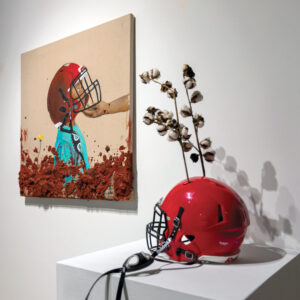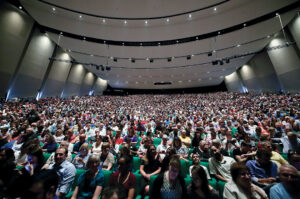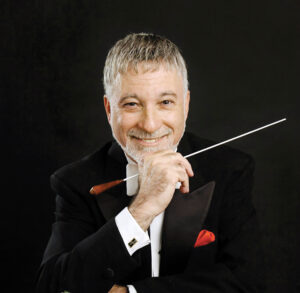How baseball saved the arts
4/3/2024The high arts are flirting with existential jeopardy. What are the “high arts?” Late Des Moines artist Don Dunagan explained:
“ ‘Titanic’ defined it. The music on the first class level was ‘high,’ and the music in steerage was ‘low.’ So were the clothes and food.”
High arts’ elitism has always been swallowed with a dose of suspicion at the grass root level. The word “haughty” derives from the French “haute,” as in “haute cuisine.” Cost/benefit analyses today discount the value of college degrees in many liberal arts. Electricians, plumbers, and carpenters scoff at job opportunities for art history, poetry and opera majors.
Still, higher education provides clarity about the highs and lows of the art world. John A. Fisher was a University of Colorado eclectic superstar. The school’s professor emeritus of philosophy, he came from physics and published significant works on phenomenological research, songs and aesthetics.
“ ‘Hamlet’ vs. Bugs Bunny, string quartets vs. rap music, J. Alfred Prufrock vs. Sam Spade. These contrasts evoke a familiar cultural divide typically expressed as the differences between high and low art,” he wrote.
Fisher noted that traditional forms of art occupy the “high” ground, and that new things don’t — until they become traditional compared to the next new thing. A good part of the high arts’ current problem is that they have remained relatively untouched by new things.

“Pressure” by b. Robert Moore. Robert Moore’s exhibition at Moberg last year teed up this year’s Robert Moore show at Des Moines Art Center.
Stuck in the same hardening mud
By numbers of performances and productions, the most popular operas in today’s world were all written considerably more than 100 years ago. The leading source of opera data, Operabase, ranked the top 10 operas of 2018-19, the last year before COVID interruptions went viral: Giacomo Puccini (1858-1924) and Wolfgang Amadeus Mozart (1756-1791) wrote three each; Giuseppe Verdi (1830-1901) created two; Georges Bizet (1838-1875) and Giachino Rossini (1793-1868) one each. As the late Des Moines Metro Opera director Robert Larsen told us, “The ’80s were music’s greatest decade, and I don’t mean the 1980s.”
Symphonic music is pretty much stuck in the same hardening mud. The top 10 most attended and performed symphonies in the year before viral shutdowns included: three by Johannes Brahms (1833-1897), two each by Ludwig van Beethoven (1770-1827), Mozart again, and Gustav Mahler (1860-1911), plus one by Piotr Ilyich Tchaikovski (1840-1893).
If you go to the top 40, you get more by those same five guys plus George Gershwin (1898-1937), Aaron Copland (1900-1990), Richard Strauss (1864-1949), Gaetano Donizetti (1797-1848), Bela Bartok (1881-1945), Sergei Prokofiev (1890-1953), Sergei Rachmaninoff (1873-1943), and Bedřich Smetana (1824-1884). The most recent work of those composers is 70 years old.
That is not necessarily the problem. All of today’s opera and classical music companies have valiantly tried to incorporate new stuff and adapt successes from the “low” arts. Des Moines Symphony will include a breakdance company in this April’s performances of Beethoven’s “Grosse Fuge.”
The Metropolitan Opera of New York (The Met) embraced the then-new art form of radio 88 years ago with “Live from The Met” performances. Those developed new, younger audiences, including this writer. In recent years, The Met featured live performances shown in movie theaters (Jordan Creek 20 and The Palms, locally), once considered “low” art compared to live theater. Then television elevated them both. Those cinema performances became a significant revenue source before the pandemic.
The Met performed an opera based on a movie, based on a best-seller, in Sing Sing prison. Unlike Johnny Cash’s concert at Folsom prison, it was not made into an album that sold 3.4 million copies. In fact, the composer of “Dead Man Walking,” Jake Heggie, has not even become a household name outside serious opera circles, and he is the most performed living opera composer of the last 20 years.
Opera and symphonic audiences want to hear “the stars of the ’80’s” and even older guys’ stuff. Earned income is not as important to endowed non-profit businesses as it is to for-profit businesses. Does that matter?

Audience from the stage of the Des Moines Symphony home at the Civic Center
How badly do the high arts ail?
Most endowments come with the caveat “never spend the principle.” Still reeling from disruptions carried by the virus from Wuhan, The Met admitted this year that it had withdrawn nearly $70 million in emergency funds from its endowment to survive downturns in attendance. Both live operas in New York and worldwide cinema operas have lost significant revenue. Lately, The Met has gone back to producing more popular traditional works compared to experimental, contemporary and political operas.
Central Iowa’s high arts organizations seem to have weathered the pandemic better than most urban places. The Des Moines Symphony’s 2020 IRS filing showed $3.2 million in total revenue and $3.5 million in total expenses. Of the revenue, $1.06 million came from program services, mainly ticket sales and academy tuition. More came from gifts, grants and contributions.
Des Moines Metro Opera (DMMO) spent about $1.5 million more than it took in during fiscal year 2021. Those aren’t bad numbers because earned income always needs to be supplemented by largess of fans. DMMO emerged from COVID days by giving audiences traditional operas by Bizet, Gershwin, Prokofiev, Bartok, Tchaikovsky, Mozart and Broadway darling Stephen Sondheim.
Songs of carnage, with lyrics
New York Times looked at Chicago’s Lyric Opera (LOC) to describe the good old days — and confusing accounting.
“It looked like a typo. For many years, until as recently as 2001, Lyric Opera of Chicago reported selling more than 100% of its capacity. The company was not squeezing opera buffs into the aisles of its Art Deco opera house, which sits at the base of a 45-story limestone skyscraper on the Chicago River. No, back then, Lyric largely sold out to subscribers, who would donate tickets they couldn’t use back to the company — which could (and often would) sell them a second time.”
In the most recent fiscal year statement, LOC showed a healthy budget surplus. But they did that by reducing the number of operas performed and adding Broadway musicals and hip-hop. Still, according to a Chicago Tribune story in 2017, “Annual revenue at the Lyric Opera has declined over the last four years.”
Other companies named lyrical or lyric have been cursed by times that inspire nothing “beautiful or imaginative,” the words Oxford uses to define lyrical. Baltimore’s Lyric Performing Arts Center (LPAC) has a history that illustrates several problems of the haute artes. It operates out of a magnificent building modeled on Amsterdam’s Concertgebouw. It opened with legendary Australian soprano Nellie Melba (of peach melba fame) singing and was known as Lyric Opera House before Baltimore’s opera company liquidated in 2009.
After the opera folded, LPAC was thrown a $3.5 million life raft by Baltimore Ravens owner Art Modell. Ten years later, LPAC told Modell his name would be removed from the center unless he doubled down on his gift. He declined.
Recently, LPAC was bailed out by a $3.4 million “Shuttered Venue Operators” grant from the U.S. Small Business Administration. According to the Baltimore Sun, “that means the concert hall can pay its bills as it begins its fiscal year and prepares to once again welcome live audiences. But the one-time grant isn’t a permanent solution to the serious financial woes that existed long before the beleaguered 127-year-old institution was upended by the COVID-19 pandemic.”
Citing financial hardship, Lyric Opera Virginia cancelled its second season in 2013 after selling ticket subscriptions. The problem with many high arts companies is immigration — nothing current or political. Classical music companies in New York, Chicago, Baltimore and many other U.S. cities were buoyed by 19th century European immigrants dedicated to the music of their homelands.
Even today, the world’s most successful opera cities, in number of productions, attendance and performances, are mostly European. Berlin unanimously tops all such lists, and of non-European cities, only New York and Sydney manage to sneak into top 20 rankings. The European immigrants who made The Met a reality in 1883, that glorious decade again, died, and their future offspring lost their love of the high arts in America’s rock and roll melting pot.
“In the 18th and half way through the 19th century, European immigrants dominated audiences, and people waited years to buy season tickets. Today, you or I could walk up to the box office for Yo Yo Ma at the New York Philharmonic and buy a ticket without scalper involvement,” explains Des Moines Symphony maestro Joe Giunta.
Art museums do not have the same problem of being stuck in the past like opera and symphony companies do. They remain current because independent galleries provide a farm system of emerging talent, while actually making a profit. Last year’s enthusiastically received exhibition of young, living artist Robert Moore’s paintings at Moberg Gallery teed up this summer’s Robert Moore show at Des Moines Art Center (DMAC). That kind of synergy has transfused museums around the world for centuries.
“States of Being,” DMAC’s current feature exhibition, demonstrates the synthesis of opposing ideas in confrontation. It brilliantly illustrates the Hegelian Dialectic by exhibiting creations of artists transplanted from one culture to another, very different one. It inspired this story by showing how new ideas spring from looking in places that shatter our comfort zones. As John Maynard Keynes famously said, “The expected never happens. It is the unexpected always.”
The great German painter Neo Rauch visited Des Moines in 2018 for the first-ever museum show of his drawings, which had been curated from Rauch’s Leipzig studio floor by former DMAC director Jeff Fleming. Because Rauch grew up an orphan in the old East Germany (GDR), we asked him about his impressions of stepping out of comfort zones and confronting antithetical situations.

Joseph Giunta
What inspired him the most in Iowa?
“The antique stores. They are amazing, and we don’t have anything like them in Germany. Our antiques are completely different. It is important for me to imagine the past. Different things are inspirations.”
What changed for him personally when The Wall came down?
“As a painter, I miss the GDR. There was an emphasis on targeted excellence in education. Now, education is general, and everyone is an artist. This is the best Germany ever but, I am happy to have grown up where and when I did. I could never live in Italy. There is too much harmony, beauty and sweetness there. Italy is the Motherland. Germany is the Fatherland. Fatherland has higher expectations.”
Because opera and symphony companies need to recruit new and future patrons, musicians, and fans, we found an anticrime program in Juarez, Mexico, inspiring. Ciudad Juarez is the sister city of El Paso, but the similarities are pretty much limited to geography. The splendid TV series “The Bridge” illustrated the oppositions that border each other — namely that Juarez has been the murder capital of the world in years when El Paso’s murder and crime rates were among the lowest in the U.S.
Juarez violinist Jové García opened an after-school program that teaches 250 children how to play an instrument or sing in a choir. His main goals are to keep the children safe from gang life and give them an opportunity to better their lives.
“The gangs, they start doing drugs, drinking and even getting killed, so I think the most important thing of this program is that we’re saving lives,” he told NBC News.
The students are part of a youth orchestra called Orquesta Sinfónica Esperanza Azteca. With donations from local businesses and secondhand instruments donated by enthusiasts from all over, Garcia is also creating a future for classical music in Juarez.
What’s baseball got to do with it?
Nothing is more antithetic to the arts than sports. Jocks are the in-crowd, and artists the outsiders in scores of formulaic Hollywood movies. So, what if the high arts looked for dialectic resolution in sports?
Two sports are distinctively viewed as more artistic than others. Soccer has been known as joga bonito since 1970 when Brazil’s national selection won the World Cup with “total football” teamwork that has been emulated ever since. Interestingly, the Portuguese term joga bonito is used all over the world but not in Brazil, where the same style is called futbol-arte. Maybe soccer is too much like the high arts to provide an antithesis. After all, its fans sing and dance and play musical instruments.
Baseball is unique. It is about going out and returning home rather than warring over territory and sacking opponents like American football, hockey and basketball. It also has unique organization.
Baseball’s farm system has nourished the sport for more than 100 years. Major league clubs control talent that is developed at several levels — developmental league, Rookie League, class A, high A, double A and triple A. Des Moines’ professional baseball team is the AAA representative of the major league Chicago Cubs.
Talent sometimes makes its way up the complete ladder. Most progress through two or three levels before either making the big league or dropping out of the system. Baseball talent and opera/orchestral talent both develop progressively.
Wouldn’t it be mutually beneficial for the Lyric Opera of Chicago or the Chicago Symphony to affiliate with opera and symphonic companies in Des Moines? Young artists would surely appreciate a system with such growth opportunities. No doubt it would please Iowa audiences if a Chicago Symphony violinist or an LOC understudy performed in Iowa.
It took baseball’s minor league teams a long time to recognize that the system provided stars that could draw fans. Now it is heavily promoted when a Chicago Cubs superstar plays in Des Moines to rehab after injury. Also, young super prospects draw fans eager to see them “on their way up.”
Minor league teams build bases of loyalty. Des Moines baseball fans are Chicago Cubs fans, more so than they are fans of much closer teams in Kansas City and Minneapolis. That’s not just coincidence.
Professional basketball and hockey teams saw the light that baseball’s farm system shines. A hundred years after baseball did it, they now have affiliated with minor league teams. Both Des Moines’ hockey and basketball teams have such relationships with major league teams in the Twin Cities.
Farm systems could facilitate fabulous things like the Orquesta Sinfónica Esperanza Azteca. At the least, they would provide high arts entities with their most critical needs — developing new talent, audiences, and patronage.
Des Moines Symphony maestro Joseph Giunta would be back at home plate with a Cubs-like affiliation, though he has more affinity with Chicago’s other team.
“I was a student at Northwestern studying conducting. The Chicago Symphony was the place to be. (Owner) Bill Veeck wanted a young conductor to direct the organ player in a rendition of ‘Take me out to the ball game.’ So I did it, in full tails, and there was a five-second delay between the organ and being able to hear the crowd sing along. I think I lost 10 pounds in a minute and a half worrying if that was working. That was my first big conducting event.” ♦





















